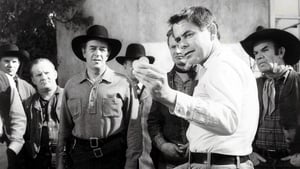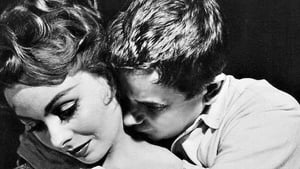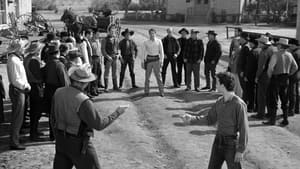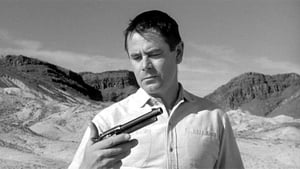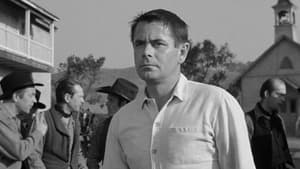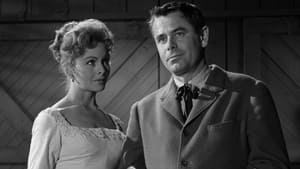Contact: info@alwanfilm.com
Video Sources 0 Views
- Watch trailer
- The Fastest Gun Alive

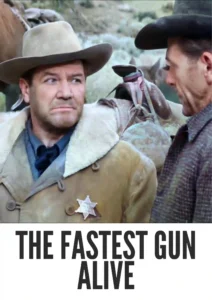
Synopsis
Table of Contents
ToggleThe Fastest Gun Alive 1956 Colorized: A Colorful Review of a Classic Western

Introduction
In the annals of old movies, few stand as tall as “The Fastest Gun Alive 1956.” This Western classic has been a staple of cinema history, captivating audiences with its gripping tale of honor, deception, and redemption. Now, with the release of its early colored version, the film takes on a new dimension, inviting viewers to experience its timeless story in vibrant hues. In this article, we embark on a journey to explore the impact of colorization on the viewing experience of “The Fastest Gun Alive 1956,” shedding light on its significance in the realm of film history.
Check The Full Colorized Movies List
Check Our Colorized Movies Trailer Channel
Understanding The Fastest Gun Alive 1956 Colorized: Director, Cast, and Genre
Directed by the acclaimed filmmaker Russell Rouse, “The Fastest Gun Alive 1956” boasts a stellar cast led by the incomparable Glenn Ford in the role of George Temple, a quiet storekeeper with a secret past. Supported by luminaries such as Jeanne Crain and Broderick Crawford, Ford delivers a tour de force performance that solidifies his status as one of Hollywood’s most iconic leading men.
Russell Rouse’s vision for “The Fastest Gun Alive 1956” is one of authenticity and depth, capturing the essence of the Western genre with stunning precision. With its sweeping vistas, tense gunfights, and rich character development, the film stands as a testament to Rouse’s mastery of cinematic storytelling.
Exploring the World of The Fastest Gun Alive 1956 Colorized: Plot and Characters
Set against the backdrop of the Old West, “The Fastest Gun Alive 1956” follows the story of George Temple, a former gunslinger who seeks to leave his violent past behind and live a quiet life with his wife, Dora. However, when his reputation as the fastest gun in the West is called into question, George finds himself drawn back into a world of violence and danger.
As the plot unfolds, viewers are introduced to a colorful cast of characters, each with their own motivations and desires. From the ruthless outlaw Vinnie Harold to the enigmatic gunslinger Lou Glover, the film is populated by a diverse array of personalities, each playing a pivotal role in George’s journey of self-discovery.
The Art of Film Colorization
Colorization is more than just a technical process; it’s an art form unto itself, capable of transforming the look and feel of a film in profound ways. By infusing each frame with vibrant hues and tones, colorization breathes new life into classic movies, revitalizing them for modern audiences while preserving their vintage charm.
In the case of “The Fastest Gun Alive 1956,” colorization adds an extra layer of visual richness to an already captivating story. From the sun-drenched plains to the dimly lit saloons, the colors leap off the screen, immersing viewers in the rugged beauty of the Old West.
Early Colored Films: A Brief History
The history of early colored films is a testament to the ingenuity and creativity of filmmakers throughout the ages. From the hand-tinted frames of silent cinema to the groundbreaking Technicolor process, color has always played a central role in the evolution of the medium.
In the early days of cinema, color was often added to films by hand, with artists painstakingly painting each frame to create the illusion of depth and dimension. However, as technology advanced, filmmakers began experimenting with new techniques, leading to the development of processes such as Technicolor and Eastmancolor, which revolutionized the way films were made and viewed.
The Fastest Gun Alive 1956 and Its Early Colored Version
The decision to release “The Fastest Gun Alive 1956” in a colorized format speaks to the enduring popularity of the film and its timeless appeal. While some may argue that colorization alters the director’s original vision, others see it as a way of breathing new life into classic movies, making them more accessible to modern audiences.
For many viewers, the early colored version of “The Fastest Gun Alive 1956” offers a fresh perspective on a beloved Western. By adding color to the film’s sweeping vistas and epic gunfights, colorization enhances its visual impact, drawing viewers deeper into the story and characters.
The Debate Over Film Colorization
The debate over film colorization is a contentious one, with passionate arguments on both sides of the issue. While purists may argue for the preservation of films in their original black and white format, others see colorization as a way of bringing classic movies to a new generation of viewers.
Critics of colorization often argue that it detracts from the artistic integrity of a film, altering the director’s original vision and compromising its aesthetic appeal. However, proponents of colorization see it as a way of updating old movies for modern audiences, making them more relevant and engaging in today’s digital age.
Examining The Fastest Gun Alive 1956 as an Early Colored Film
Colorization adds a new dimension to “The Fastest Gun Alive 1956,” enhancing its visual appeal while preserving its vintage charm. From the dusty streets of the frontier town to the blazing sunsets of the open range, the colors serve to underscore the film’s epic scope and grandeur.
In addition to its aesthetic impact, colorization also adds depth to the film’s narrative, with certain colors carrying thematic significance. For example, the use of warm tones may evoke feelings of nostalgia and longing, while cool tones may convey a sense of danger and uncertainty. By manipulating color in this way, filmmakers can enhance the emotional impact of a scene and draw viewers deeper into the story.
Influence and Legacy: The Fastest Gun Alive 1956 Colorized’s Impact on Cinema
“The Fastest Gun Alive 1956” has left an indelible mark on the Western genre, inspiring countless filmmakers and audiences alike with its timeless tale of courage and redemption. Its influence can be seen in the works of directors such as Sergio Leone and Clint Eastwood, who have drawn inspiration from its iconic imagery and themes.
One of the most enduring legacies of “The Fastest Gun Alive 1956” is its exploration of the myth of the American West and the complex morality of its characters. Through its nuanced portrayal of heroism and villainy, the film challenges traditional notions of right and wrong, inviting viewers to question their own beliefs and assumptions.
Director’s Cinematic Legacy: Beyond The Fastest Gun Alive 1956 Colorized
Russell Rouse’s contributions to cinema extend far beyond “The Fastest Gun Alive 1956,” with a body of work that spans multiple genres and styles. From gritty crime dramas to heartfelt comedies, Rouse’s films have captivated audiences with their compelling characters, engaging storytelling, and timeless themes.
Rouse’s influence on the Western genre is particularly notable, with “The Fastest Gun Alive 1956” standing as a shining example of his talent and vision. His meticulous attention to detail, coupled with his ability to craft memorable characters and riveting plots, has earned him a place among the pantheon of great American filmmakers.
Themes Explored in The Fastest Gun Alive 1956 Colorized
At its core, “The Fastest Gun Alive 1956” is a meditation on the nature of heroism and the power of redemption. Through its complex characters and moral dilemmas, the film explores timeless themes of honor, loyalty, and the pursuit of justice in a lawless land.
George Temple, the film’s protagonist, is a reluctant hero who must confront his own demons and make difficult choices in order to protect the ones he loves. His journey is one of self-discovery and redemption, as he learns to reconcile his past with his present and forge a new future for himself and his family.
Reception and Controversy Surrounding The Fastest Gun Alive 1956 Colorized
Upon its release, “The Fastest Gun Alive 1956” received widespread critical acclaim for its gripping storyline, dynamic performances, and stunning visuals. Critics praised the film’s realistic portrayal of life in the Old West, as well as its exploration of complex moral themes.
However, the decision to release the film in a colorized format sparked controversy among purists, who argued that it detracted from the director’s original vision. Despite these objections, many viewers embraced the early colored version of the film, praising its vibrant visuals and enhanced viewing experience.
Where to Watch The Fastest Gun Alive 1956 Colorized Online
For those eager to experience the timeless charm of “The Fastest Gun Alive 1956,” the film is available for streaming on various platforms, ensuring that its legacy will continue to captivate audiences for years to come. Whether viewed in its original black and white format or the early colored version, “The Fastest Gun Alive 1956” promises an unforgettable cinematic journey.
FAQs About The Fastest Gun Alive 1956 Colorized
Frequently Asked Questions (FAQs) about “The Fastest Gun Alive 1956” provide valuable insights into various aspects of the film, from its production history to its cultural impact:
1. What is the plot of The Fastest Gun Alive 1956?
“The Fastest Gun Alive 1956” follows the story of George Temple, a former gunslinger who seeks to leave his violent past behind and live a quiet life with his wife, Dora. However, when his reputation as the fastest gun in the West is called into question, George finds himself drawn back into a world of violence and danger.
2. Who are the main actors in The Fastest Gun Alive 1956?
The main actors in “The Fastest Gun Alive 1956” include Glenn Ford as George Temple, Jeanne Crain as Dora Temple, and Broderick Crawford as Vinnie Harold. Together, they deliver captivating performances that bring the film’s characters to life and elevate the viewing experience to new heights.
3. What is the significance of colorization in The Fastest Gun Alive 1956?
Colorization adds a new layer of visual richness to “The Fastest Gun Alive 1956,” enhancing its aesthetic appeal while preserving its vintage charm. By infusing each frame with vibrant hues and tones, colorization breathes new life into the classic Western, revitalizing it for contemporary audiences.
4. How does The Fastest Gun Alive 1956 compare to other films of its genre?
“The Fastest Gun Alive 1956” stands out among other films of its genre due to its gripping storyline, dynamic performances, and stunning visuals. Director Russell Rouse’s masterful direction and Glenn Ford’s charismatic lead performance elevate the film to classic status, making it a must-see for fans of the Western genre.
5. Where can I watch The Fastest Gun Alive 1956 online?
“The Fastest Gun Alive 1956” is available for streaming on various platforms, allowing audiences to experience the timeless charm of this classic Western from the comfort of their own homes. Whether viewed in its original black and white format or the vibrant hues of colorization, “The Fastest Gun Alive 1956” promises an unforgettable cinematic journey.
Conclusion
In conclusion, “The Fastest Gun Alive 1956” stands as a timeless classic that continues to captivate audiences with its gripping storyline, dynamic performances, and stunning visuals. Whether viewed in its original black and white format or the early colored version, the film offers a compelling exploration of honor, redemption, and the power of the human spirit. As we reflect on its enduring legacy and cultural significance, we are reminded of the timeless appeal of the Western genre and the enduring power of cinema to entertain, inspire, and provoke thought. “The Fastest Gun Alive 1956” is a true masterpiece of old movies, deserving of its place in the pantheon of great American films.
